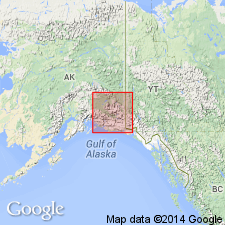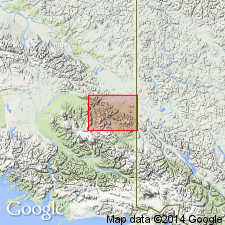
- Usage in publication:
-
- Nabesna limestone*
- Modifications:
-
- Named
- Dominant lithology:
-
- Limestone
- AAPG geologic province:
-
- Alaska Southern region
Summary:
[Presumably named for Nabesna River, Wrangell Mountains, southern AK]. Type not designated. Consists of generally thick-bedded, mostly white limestone and darker gray or bluish dolomitic limestone comprising a "series of limestones occurring on the upper Nabesna and Chisana rivers ... almost entirely restricted to the Wrangell Mountains". No age-diagnostic fossils found within unit; age regarded as Permian based on regional biostratigraphic correlations.
Source: GNU records (USGS DDS-6; Menlo GNULEX).

- Usage in publication:
-
- Nabesna limestone*
- Modifications:
-
- Age modified
- Biostratigraphic dating
- AAPG geologic province:
-
- Alaska Southern region
Summary:
Unit thickness at White Mountain is approximately 2000 ft. Age is considered to be Late Triassic [overall] based on occurrence of age-diagnostic fossils (including MONOTIS) from correlative limestones to the east in Snag Creek valley and nearby locales.
Source: GNU records (USGS DDS-6; Menlo GNULEX).
For more information, please contact Nancy Stamm, Geologic Names Committee Secretary.
Asterisk (*) indicates published by U.S. Geological Survey authors.
"No current usage" (†) implies that a name has been abandoned or has fallen into disuse. Former usage and, if known, replacement name given in parentheses ( ).
Slash (/) indicates name conflicts with nomenclatural guidelines (CSN, 1933; ACSN, 1961, 1970; NACSN, 1983, 2005, 2021). May be explained within brackets ([ ]).

